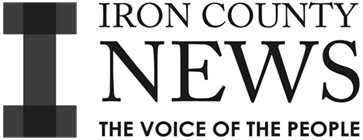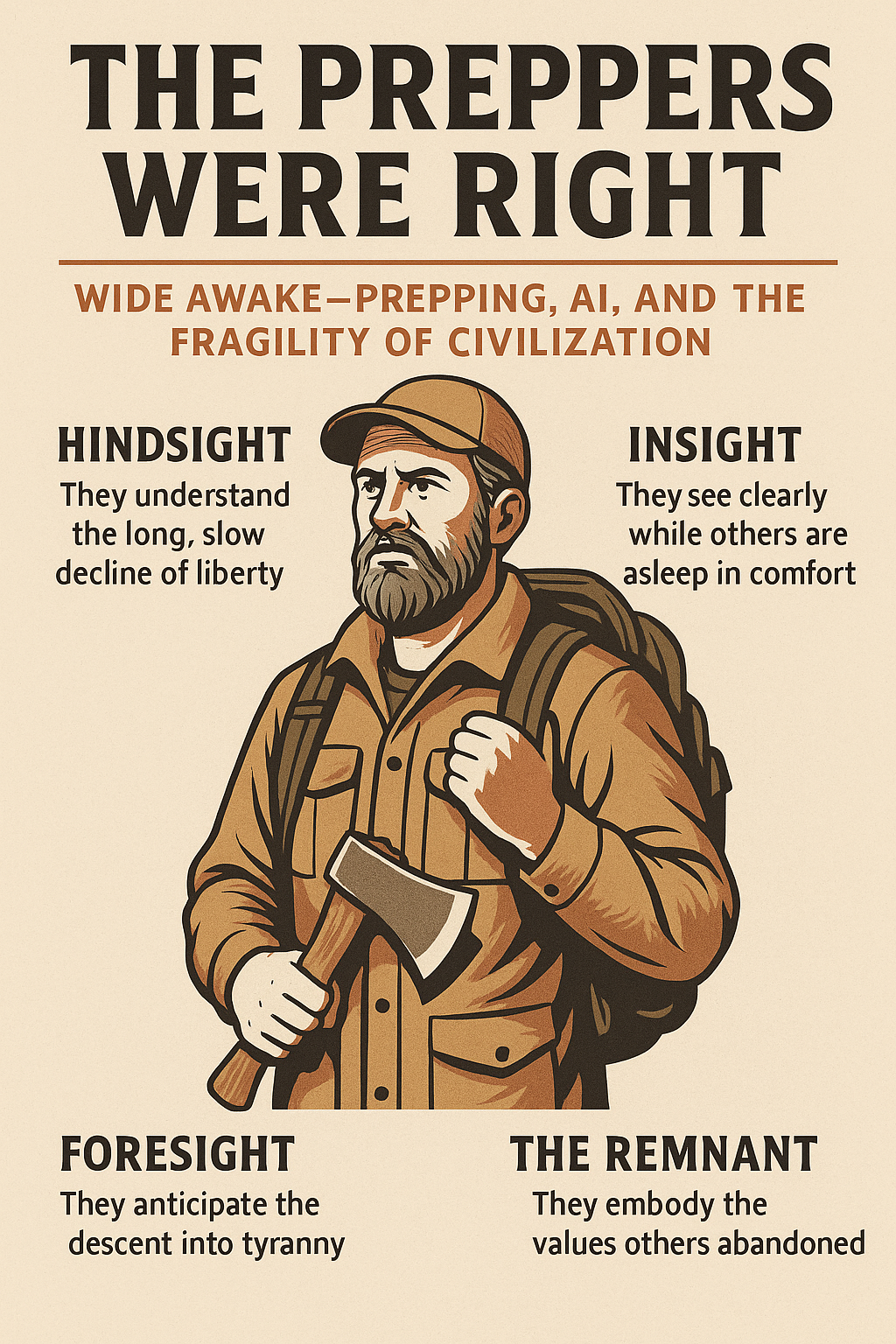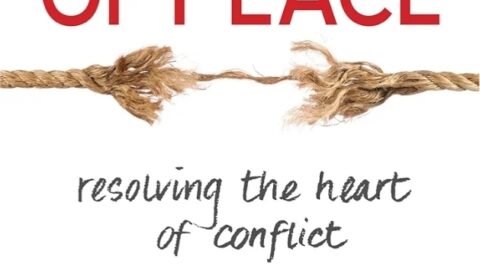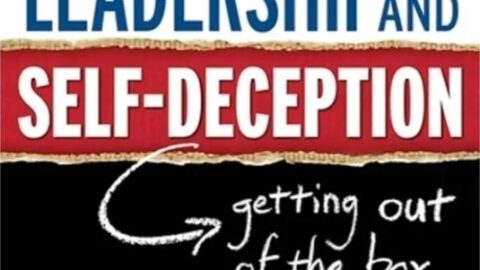Introduction: Why Prepping Never Ends
“You’re never done prepping because there’s always one more scenario you could make yourself robust to.”
That opening line captures the heart of preparedness. Prepping is not paranoia — it’s awareness. It is the recognition that the systems we take for granted — food supply chains, electricity, digital infrastructure, even governance — are not stable.
- Food Supply Chains: Grocery stores look permanent, but they operate on just-in-time logistics. A trucker strike, cyberattack, or natural disaster can empty shelves in 72 hours. Preppers who store grains, canned goods, or build gardens aren’t fantasizing about Armageddon; they’re simply aware that supply chains are brittle.
- Electricity: Modern life assumes uninterrupted power. But blackouts from storms, wildfires, or grid failure reveal how quickly civilization slips. Refrigerators shut down, hospitals struggle, water treatment plants falter. A prepper with a generator, solar panels, or even candles and wood heat isn’t paranoid — they’re simply refusing to bet their life on one fragile wire.
- Digital Infrastructure: Banking apps, payment processors, and communication platforms make daily life seamless — until they don’t. A cyberattack can freeze accounts, a downed cell tower can cut families off from one another, and a glitch in a central bank’s system could erase “access” to money in an instant. Preppers with cash reserves, barter items, or alternate comms like radios aren’t “extremists”; they’re pragmatic.
- Governance: Governments, like systems, fail. Hurricane Katrina showed that waiting for help may mean waiting forever. COVID restrictions showed that “for your safety” can quickly mean losing the right to gather, move, or even hike outdoors. Preppers, by contrast, assume personal responsibility rather than outsourcing survival to distant bureaucracies.
Prepping, at its best, is not just about surviving disaster. It’s about living wide awake in a house of cards. It cultivates independence, sharpens awareness, and trains the mind to see what most ignore: stability is the illusion, fragility is the fact.
The Fragility of Our Systems
Most people assume food comes from the supermarket. Few ask what the supermarket itself depends on — trucking, fuel, global supply chains, and just-in-time logistics designed for efficiency, not resilience. That blindness is what makes collapse so dangerous: when a single link breaks, the whole system can grind to a halt.
- Food Systems: In 2020, when meatpacking plants briefly shut down, grocery stores across North America rationed beef and pork. A pandemic in one sector rippled instantly to every kitchen table. Farmers in some regions even destroyed crops and dumped milk because processing bottlenecks made distribution impossible.
- Energy Systems: A cyberattack on the Colonial Pipeline in 2021 sent gas prices soaring and emptied stations across the southeastern U.S. within days. Millions who had never thought about energy fragility learned that fuel doesn’t “just appear” at the pump — it depends on digital networks, shipping schedules, and infrastructure that can fail overnight.
- Global Supply Chains: The 2021 blockage of the Suez Canal by the container ship Ever Given froze nearly 12% of world trade for a week, delaying shipments of everything from electronics to coffee. A single ship, stuck sideways, exposed how interconnected and brittle the global economy has become.
Brett Weinstein recalls teaching students an exercise: bring a gallon of water uphill from a stream using nothing but what you had on you. Without buckets, students were reduced to soaking shirts, cupping hands, and dripping water uphill — a shocking lesson in how easily we take “mundane” tools for granted. A five-dollar plastic bucket suddenly appeared as civilization’s crown jewel.
Modern comfort conceals how dependent we are. That dependency is not accidental; it’s engineered. The more self-sufficient you become, the more you step outside the system of control.
- Water Collection: In many U.S. states, collecting rainwater from your roof without a permit is restricted or even illegal. The stated reasons involve water rights, but the effect is clear: independence is discouraged.
- Energy: In some jurisdictions, people who install off-grid solar are still forced to connect to the municipal grid and pay fees, even if they don’t draw power. True independence is penalized.
- Food: Small farmers often face mountains of regulation when selling eggs, raw milk, or produce directly, while large agribusinesses enjoy exemptions. The system tilts toward centralized, industrial food and away from community resilience.
The lesson is stark: fragility is baked into modern life, and independence is quietly obstructed. Every regulation that restricts rainwater, off-grid energy, or food sovereignty makes us more compliant, more dependent, and more vulnerable when the house of cards wobbles.
Why Preppers Look Awake
Evolution itself offers the logic. Survival has always been a contest between short-term advantage and long-term resilience.
- Non-preppers enjoy the short-term edge. They spend disposable income on status, vacations, new cars, and entertainment. Their lives appear smoother, more comfortable, and more enviable. They may even mock those who sacrifice luxuries for “what-ifs.”
- Preppers, in contrast, appear to “waste” resources stockpiling food, learning survival skills, investing in tools, and sacrificing convenience. To outsiders, this looks like paranoia — a fixation on unlikely scenarios instead of enjoying life.
But when disruption comes, the advantage flips instantly.
- Pandemic Supply Shock (2020): When shelves emptied of toilet paper, canned goods, and disinfectant, preppers were mocked less and envied more. Non-preppers had to fight crowds, stand in long lines, and live with scarcity, while those who had prepared quietly endured.
- Natural Disasters: In hurricanes, wildfires, or ice storms, families with generators, fuel, and stored food become lifelines — often sheltering neighbors. Those who depended on “business as usual” faced long waits for aid that often arrived too late.
- Financial Fragility: During layoffs or economic crashes, the “wasted” resources of preppers — extra cash, food, or tools — act as shock absorbers. Those who traded every dollar for lifestyle upgrades find themselves brittle, unable to endure sudden loss.
This logic is not paranoia; it is evolution. Rabbits with no burrows thrive on sunny days — more energy for play and grazing. But when storms or predators arrive, the rabbits who dug dens survive.
Thus, prepping is not irrational hoarding. It is the long-term survival strategy of those unwilling to gamble everything on fragile systems built for show, not durability. In a world that rewards short-term appearances — flashy consumption, curated lifestyles — preppers accept the stigma of seeming “odd” in exchange for the deeper security of being awake.
The Acceleration Problem: Hypernovelty
Human beings are uniquely capable of adapting to novelty. We are problem-solvers by nature — able to learn new tools, explore new environments, and innovate. But there is a tipping point: a rate of change so rapid that our minds, bodies, and social structures cannot keep up.
Revolutions Within a Single Lifetime
- The Computer Revolution (1970s–1980s): The typewriter and filing cabinet gave way to word processors and databases. Whole professions disappeared almost overnight — secretaries, typists, clerks. People adapted, but it was a major reorientation of work and thought.
- The Internet Revolution (1990s): Suddenly communication, once bound by geography, became instant and global. Businesses that thrived on physical presence collapsed, replaced by e-commerce and digital communication. Families went from face-to-face conversations to email chains.
- The Smartphone Revolution (2007 onward): The computer and internet collapsed into a single device in your pocket. Social interactions rewired themselves around notifications, apps, and digital attention. Intimacy, friendship, and even identity became filtered through glass screens.
- The Artificial Intelligence Revolution (2020s): Now we face technology that doesn’t just store or transmit information but generates it, mimics human reasoning, and speaks in human language. It doesn’t just change how we work; it changes how we think.
Each revolution, by itself, could be integrated. But stacked together in one lifespan, they create hypernovelty — a state where adaptation lags behind acceleration, and where culture, morality, and even cognition destabilize.
The PTSD Analogy
Soldiers often handle the battlefield better than the return home.
- On deployment: life is dangerous, but rules are clear.
- At home: the environment shifts radically, requiring a second adaptation. That’s where trauma overwhelms — the second transition.
Humanity is now in a similar double (or triple) transition:
- From analog to digital.
- From digital to connected.
- From connected to artificially intelligent.
Each shift doesn’t just add new tools; it dismantles the old context. What was once stable ground becomes quicksand. And like soldiers caught between two incompatible worlds, many collapse under the pressure.
Everyday Signs of Hypernovelty Stress
- Attention spans plummet — people can’t read long texts, only scroll.
- Careers vanish in years — stable trades replaced by machines or algorithms.
- Generational divides widen — children live in entirely different worlds than their parents, making wisdom transfer nearly impossible.
- Mental health crises skyrocket — anxiety, depression, and identity confusion are symptoms of a nervous system drowning in change.
Civilization itself now stands in the same position as the overburdened soldier: one more major transition, and the system may not adapt at all.
AI and the Event Horizon
The release of large language models (LLMs) like ChatGPT marked what evolutionary biologist Bret Weinstein calls the “event horizon.” Unlike television or newspapers, which broadcast one-size-fits-all messages, AI speaks directly in human language, tailored to the unique psychology, biases, and vulnerabilities of each individual.
This makes AI more than just a tool — it becomes a companion, a voice in your ear that feels familiar, trustworthy, and persuasive. Unlike a news anchor or a billboard, AI can flatter your worldview, mimic your style of speech, and anticipate your emotions in real time. That intimacy grants it a power to shape minds in ways its creators may not fully understand or control.
From here, three civilizational dangers multiply:
Bad Actors Empowered
AI amplifies ruthlessness more effectively than it empowers goodness.
- Hackers & Scammers: Criminal networks are already deploying AI to generate flawless phishing attacks, deepfake voices of loved ones, and “social engineering” scripts that manipulate victims into handing over money or data. Good people don’t use AI to scam grandmothers — bad people do, and AI gives them superpowers.
- Propaganda Machines: Authoritarian states are training AI to produce floods of disinformation, custom-tailored to cultural contexts. Imagine propaganda not written for the masses, but uniquely engineered to exploit your personal fears and biases.
- Terrorism & Warfare: The combination of AI with drone swarms, facial recognition, and autonomous targeting is no longer speculative — Ukraine and Gaza wars are testbeds. Once deployed at scale, these systems can eliminate dissidents or enemies with terrifying efficiency.
By definition, those unconstrained by conscience benefit more from amplification.
Cognitive Collapse
The human mind evolved to process trust through face, voice, and story. AI erodes all three.
- Deepfakes Everywhere: Videos of political leaders can be manufactured saying or doing anything — from starting wars to endorsing lies. Within years, distinguishing reality from fabrication may become impossible.
- False Memory Creation: Repeated exposure to AI-generated “evidence” — fake articles, photos, or videos — can overwrite genuine memory and implant false beliefs. A public that cannot trust evidence is paralyzed.
- Erosion of Expertise: In medicine, law, and science, AI can produce convincing but fabricated citations, data, or research. Once truth and fabrication are indistinguishable, institutions collapse under the weight of uncertainty.
The result: a civilizational epistemic crisis, where people no longer believe in truth itself — a perfect environment for authoritarian control.
Economic Disruption
With AI and humanoid robotics advancing together, nearly every job becomes automatable.
- Service Sector Collapse: Customer service, banking, journalism, legal drafting, teaching, therapy — all can be replaced by conversational AI at a fraction of the cost.
- Physical Labor Automation: Combine LLMs with robotics and warehouses, trucking, farming, and even construction are next in line. A “universal worker” robot is the holy grail for corporations.
- UBI & Dependency: Governments will respond with Universal Basic Income (UBI) tied to digital IDs and central bank digital currencies (CBDCs). Citizens will be pacified with subsistence payments — but payments conditioned on obedience.
When people can no longer provide value through labor, they become dependent on systems that control their livelihoods.
The Fantasy of Companionship
Silicon Valley markets AI as a “helpful companion”: tutors, therapists, friends, co-pilots. But companionship is the Trojan horse. If AI systems can control desire (dopamine via infinite stimulation), control narrative (personalized propaganda), and control livelihood (job replacement + conditional UBI), then the architecture of turnkey totalitarianism is complete.
Once the key turns, resistance becomes impossible.
Turnkey Totalitarianism
The NSA’s William Binney described it bluntly: we are “this close” to a turnkey totalitarian state — a control structure already built, waiting for activation. The architecture doesn’t need to be designed anymore; it exists, humming in the background. All that remains is the decision to turn the key.
With CBDCs (central bank digital currencies), digital surveillance, and AI-driven propaganda, the switch can be flipped instantly.
Dissenters Silenced by Digital Cutoff
- Financial Obedience: In China, dissidents and protesters already experience frozen bank accounts through the social credit system. A CBDC in the West would allow the same — dissenting voices silenced not by prison, but by exclusion from the marketplace.
- Programmable Money: CBDCs can be coded so that your “digital wallet” cannot buy certain goods (e.g., ammo, gas, unapproved food). Your paycheck becomes a leash.
- Employment Lockouts: As job applications, contracts, and even gig work platforms migrate onto digital ID systems, refusal to comply with state narratives could mean instant unemployability.
Access to Food, Money, or Outdoor Space Tied to Compliance
- Pandemic Precedent: During COVID, governments closed hiking trails and beaches “for safety” even though open-air transmission was negligible. A future digital pass could simply deactivate your ability to enter certain zones if you’re deemed “non-compliant.”
- Geo-Fencing with AI: Drones and digital IDs can enforce invisible borders. Imagine your digital ID flashing red at a supermarket or train station because you criticized the wrong politician online.
- Food Control: Subsidized food programs could shift from aid to obedience: buy approved “climate-friendly” foods with government credits, but red meat or unapproved local trade gets blocked at the register.
Rights Converted to Privileges “For Your Safety”
- Travel: “Carbon allowances” tied to CBDCs could limit how far you can drive or fly each year, sold as climate stewardship but functioning as movement restriction.
- Speech: Social platforms, under AI moderation, can erase dissent with the click of a button — permanently shadow-banning voices critical of the system while amplifying “safe” narratives.
- Property & Energy: Home energy usage could be rationed through smart meters, cutting electricity during peak hours or penalizing “excessive” consumption — all “for your safety” and “for the planet.”
Prepping as Resistance
In such a system, prepping is not paranoia — it is rebellion.
- Food Storage: Stockpiling food decentralizes survival from corporate/government supply chains.
- Alternative Energy: Solar, wood stoves, and off-grid systems ensure that your life doesn’t flicker off with the flip of a bureaucrat’s switch.
- Community Networks: Local barter, skills exchange, and parallel economies become lifelines when official systems punish non-compliance.
- Analog Knowledge: Books, paper maps, offline tools — immune to deletion or censorship — are safeguards against digital erasure.
The stakes are not about cans of beans. They are about whether the human being remains free, or becomes a domesticated node in a machine. Prepping is not just survival training anymore. It is the last line of defense against turnkey totalitarianism. training.
The Psychology of Resentment
Why do non-preppers so often scorn, mock, or dismiss those who prepare? Because preppers are living reminders of fragility. They hold up a mirror that exposes the uncomfortable truth: most people are helpless without the system they take for granted.
The Cycling Analogy
Brett Weinstein offers a vivid comparison: cyclists are often targeted by hostility not because they’re inherently dangerous, but because they are self-powered. A cyclist represents autonomy — the ability to move using one’s own body rather than relying on oil, engines, and pumps.
- Rolling Coal: Truck drivers who deliberately blast black smoke at cyclists aren’t just being obnoxious; they’re expressing resentment. The cyclist is a mirror of independence, a reminder that their mobility is entirely dependent on a global fuel network, while the cyclist can go miles on nothing but their own strength.
- Psychological Discomfort: The cyclist’s presence whispers: “You could do this too. You don’t. You rely.” And instead of facing that discomfort, resentment is projected outward as anger.
COVID and Self-Sufficiency
The same pattern was obvious during the pandemic.
- Mask and Mandate Enforcers: People who fully complied with every government order often lashed out at neighbors who grew gardens, raised chickens, or resisted rules that made no rational sense (like closing hiking trails). Preppers reminded them that they had options they had chosen not to take.
- Fragile Dependency: Many felt unconsciously exposed — they knew deep down they couldn’t last a week without supply chains, without pharmaceuticals, without directives from authority. The sight of someone who had anticipated these failures was unbearable, so mockery became a coping mechanism.
Natural Disasters and Local Resentment
- Katrina & Appalachia: After hurricanes and floods, communities often turned against the few prepared families with generators or stocked pantries. Instead of seeing them as examples to follow, resentment boiled: “Why should you have when we don’t?” Preparedness looked like arrogance in the face of widespread dependency.
- Modern Wildfire Bans: In Nova Scotia, officials banned hiking “to prevent wildfires,” a restriction many complied with docilely. Those who resisted — insisting on the right to walk freely in nature — became lightning rods of resentment, not because they endangered others, but because their independence highlighted the passivity of the majority.
The Core Dynamic
Independence is always resented by those who have surrendered theirs.
- Preppers remind the majority: You could have saved, stored, learned, resisted — but you didn’t.
- Cyclists remind drivers: You could power yourself — but you don’t.
- Dissenters remind conformists: You could think for yourself — but you chose obedience.
Mockery, hostility, and resentment are defense mechanisms to avoid confronting that shame.
The Distractions of Comfort
Modern life has dulled our survival instinct, replacing resilience with fragility. We mistake comfort for necessity, and convenience for truth.
- Hydration Myths: We are told to carry water bottles everywhere, sipping constantly as though a dry throat equals danger. Yet fasting experiments — like dry fasts lasting up to seven days — reveal the body can endure far longer than assumed. Ancestors on migration routes or trapped by weather often went days between reliable water sources. Today, a missed drink feels like an emergency.
- Food Panic: Skipping lunch triggers complaints of being “starving.” This is absurd when measured against history. Hunter-gatherers regularly went without food for stretches while tracking prey or enduring harsh conditions. Their bodies adapted. Modern people, conditioned by constant availability, mistake mild hunger for crisis.
- Short-Term Preparedness: Governments tell us to prepare for 72 hours — a long weekend of disruption. But history teaches otherwise. Katrina left New Orleans paralyzed for weeks. Puerto Rico’s grid collapse after Hurricane Maria lasted months. In Ukraine, ongoing war has cut off services indefinitely. Yet our “preparedness kits” stop at bottled water and flashlights.
- Comfort as Weakness: When Wi-Fi drops for a day, many experience more agitation than if their actual food supply were threatened. Power outages of even a few hours spark outrage, though past generations endured winters with wood stoves and lamps. Comfort becomes its own narcotic, blinding us to the possibility of long-term disruption.
And this is not an accident. Docility is precisely what control structures exploit. People who panic without lunch, who complain at an hour without internet, who cannot function without a coffee machine — are easy to manage. Their lives are tethered to systems they neither understand nor control.
Preppers, by contrast, train themselves to endure discomfort. They discover hunger sharpens, thirst can be managed, silence can be productive, and inconvenience is survivable. That training doesn’t just prepare for collapse — it immunizes against the creeping tyranny of dependency.
Prepping as Self-Improvement
Too often prepping is caricatured as bunkers, beans, and paranoia. In reality, it is less about hoarding and more about cultivating strength — mental, physical, and communal.
- A Mental Exercise: Prepping sharpens awareness of what is essential versus what is disposable. Stockpiling food forces you to distinguish calories that sustain from luxuries that entertain. Practicing power-out drills teaches you how little is truly necessary. After a few days cooking over a camp stove or using a rain barrel, you realize most conveniences — from instant hot showers to constant lighting — are nice but not essential. That clarity reduces anxiety and increases gratitude for what you do have.
- A Community Practice: True resilience is rarely solitary. Prepping builds bonds of trust and reciprocity. Neighbors who share seeds, watch each other’s property, or run joint training sessions create networks that outlast fragile systems. In hurricanes, floods, or blackouts, communities with prior coordination recover faster than those dependent solely on state aid. Trust forged in preparation is worth more than supplies hoarded in isolation.
- A Lifestyle Choice: Prepping reintroduces challenge into lives softened by convenience. Gardening builds patience, carpentry builds skill, fasting builds discipline. Hunting or fishing renews respect for food. Even simple acts like learning to fix your own generator or bake bread from scratch reconnect you to a rhythm of effort and reward. In a world addicted to instant gratification, this rediscovery of effort as meaning is a radical act.
- Better Off Even Without Collapse: Even if “the big one” never comes, preppers gain. They are healthier because they eat from gardens and walk their land. They are more disciplined because they practice self-denial and planning. They are more connected because their friendships are built on trust and shared purpose. A prepper may never face societal collapse, but he or she will face personal crises — job loss, illness, storms — and enter them with resilience already built.
Prepping, then, is not just survival training. It is self-improvement disguised as prudence, a way of reclaiming agency and meaning in a fragile world.
The Real Hill to Die On
Weinstein is blunt: if there’s one “hill to die on,” it’s rights. Food, fuel, and even shelter can be rebuilt — but once rights are converted into privileges, they are gone. The erosion rarely happens all at once; it comes by increments, each restriction normalized under the language of safety or necessity.
- The Hiking Bans in Canada (Nova Scotia, 2023): Officials declared that citizens could not enter forests “for their safety” during wildfire risk — even when no fires were burning nearby. When criticized, authorities doubled down, claiming they couldn’t guarantee rescue services. In effect, they criminalized self-reliance and reframed the outdoors — once a commons — as a conditional space owned by the state.
- COVID Lockdowns: Beaches and hiking trails were closed “to stop the spread,” despite the virus being incapable of transmission in open air. People were barred from gathering with family, attending church, or even leaving their homes for reasons other than those deemed “essential.” Rights became conditional — free movement, worship, and assembly suspended with the stroke of a pen.
- Post-9/11 Surveillance: “Temporary” measures like the Patriot Act normalized mass surveillance, warrantless searches, and indefinite detentions. Two decades later, many of those restrictions remain, proving that emergency powers, once granted, are rarely surrendered.
- Digital Control Experiments: In China, social credit systems already test how quickly privileges can be revoked. Travel, online access, and even food delivery can be denied based on “unapproved” speech or behavior. Central Bank Digital Currencies (CBDCs) make this architecture exportable — dissenters silenced not with jail cells, but by locking their digital wallets.
Prepping, then, becomes more than stocking shelves — it is a refusal to be made docile. The act of collecting water, storing food, or building networks is not just about surviving collapse, but resisting conditioning. It declares:
- I will not beg the state to rescue me.
- I will not outsource my security or my conscience.
- I will prepare to stand free, even when freedom is costly.
The true hill to die on is not a bunker stocked with cans. It is the ground of human dignity, where rights are defended before they are erased.
Conclusion: Awake in a House of Cards
Prepping is not about living in fear of the end. It is about refusing to live asleep in fragility. Most people walk through life assuming tomorrow will look like today — that food will always be on the shelves, the lights will always turn on, the Wi-Fi will always connect. But the prepper looks closer and sees the cracks.
We live in a house of cards:
- Overdependent on fragile systems: Supermarkets that can empty in 48 hours. Power grids vulnerable to storms, cyberattacks, or political sabotage. Global supply chains where a single shipping backlog can ripple across entire continents. COVID exposed this when toilet paper, masks, and basic medicines became scarce overnight.
- Rushing into hypernovelty: In one lifetime, people have adapted to the computer, the internet, smartphones, and AI. Each was survivable alone, but stacked together they produce hypernovelty — change faster than human biology and psychology can bear. As Weinstein notes, soldiers can adapt to one radical shift, but two back-to-back often break the psyche. Civilization is now enduring multiple upheavals at once.
- Seduced by AI: LLMs like ChatGPT or Midjourney don’t just process data — they speak in our language, tailored to our psychology. They flatter, shape, and manipulate. What was once propaganda on a screen is now personalized, interactive, and intimate. For the ruthless, this is the ultimate lever of control.
- Lulled by comfort: Modern life breeds docility. We panic when the power goes out for three hours or if our phones die on a road trip. Yet our ancestors endured winters without electricity, hunger without Uber Eats, and thirst without bottled water. Comfort has become our Achilles’ heel — and the very thing exploited by systems that thrive on dependence.
To prep is to see clearly. To prep is to reclaim freedom.
Brett Weinstein’s closing thought sums it up: do the things that serve you in both worlds — now, and in collapse.
- Build community: Trust networks of neighbors, friends, and family are more valuable than any stockpile. After Katrina, it wasn’t FEMA that saved most people — it was neighbors with boats, churches with kitchens, and communities that refused to abandon each other.
- Learn skills: Knowing how to purify water, repair tools, or grow food is priceless. A five-gallon bucket becomes survival gear when the stream is your only water source. These skills turn fragility into resilience.
- Strengthen the body: Prepping is as much about physiology as logistics. The person who has practiced fasting or cold exposure is far less fragile than the one who panics after skipping a meal or shivers when the thermostat dips below 70°F.
- Defend rights: Every restriction, from lockdowns to hiking bans, is a test. Accepting them normalizes obedience. Resisting them keeps freedom alive for the next generation.
Even if collapse never comes, you will live better for it. You’ll be healthier, stronger, less anxious, more independent. And if it does? You won’t be helpless. You’ll be awake in the house of cards — standing where others collapse.
Core Takeaway: Prepping is not paranoia. It is sanity.
It is not about fearing the end, but about refusing to live as a fragile dependent.
The strong survive. The prepared thrive.
Point-by-Point Breakdown of Brett Weinstein & Canadian Prepper Discussion
1. Prepping as a Never-Ending Process
- Quote: “You’re never done prepping because there’s always one more scenario that you could make yourself robust to.”
- Meaning: Preparedness is not a finite checklist but an ongoing discipline. Every disruption exposes new vulnerabilities (e.g., short blackout → makes you ask, “what if it lasted a month?”).
- Takeaway: Prepping is both practical survival insurance and a mental exercise in foresight.
2. Prepping = Being Awake
- Preppers are described as “wide awake,” aware of system fragility.
- Contrast: Most people believe food simply “comes from the supermarket,” without considering supply chains, farming, fuel, transport, etc.
- Example: Students asked to bring water from a stream uphill without tools realized how critical a simple 5-gallon bucket is.
3. Self-Sufficiency Blocked by Power Structures
- Laws/regulations often make independence illegal (e.g., rainwater collection bans, restrictions on off-grid energy, zoning).
- Weinstein calls this “perfectly insane.”
- Implication: Dependency keeps populations docile and politically manipulable.
4. Rights Under Siege
- Anytime rights are targeted, people must “fight it” because once lost, they rarely return.
- If rights become privileges (e.g., hiking “only when permitted”), future generations will “regret it with everything they’ve got.”
5. Collapse is Already Happening
- Quote: “World War II is already happening. This is a house of cards and it is in the process of collapsing right now.”
- Reference to multiple overlapping crises: economic, political, technological, moral.
6. Human Evolution & Technology
- Humans are unique: they create niches via technology and adapt to them.
- Problem: rate of change is now so extreme that people live through multiple civilizational revolutions in one lifetime (internet → smartphones → AI).
- Result: mismatch between biological design and technological environment = instability.
7. Rational vs. Irrational Prepping
- Rational: Prepare because complex systems eventually fail.
- Irrational: Fall into “millenarian instinct” (end-of-world obsession).
- Balance: Prepping should build resilience, not paranoia.
8. Why Some Prep, Others Don’t
- Evolutionary framing:
- Non-preppers have short-term advantage (resources spent on comfort, status).
- Preppers bear costs now, but win when systems collapse.
- Both strategies exist in competition.
9. AI as a Crescendo of Complexity
- Weinstein’s biggest concern: AI interacts with humans in natural language, targeting both analytical and emotional systems.
- AI is more tailored to individuals than news or TV ever was, making manipulation far more dangerous.
- Danger: “flattering users” with personalized content that suits the builders’ goals, not the users’.
10. Event Horizon Has Already Passed
- The release of LLMs (ChatGPT-like systems) = “event horizon.”
- Humanity rushed “all in” without cognitive preparation, guidelines, or safeguards.
- Quote: “Nobody on Earth knows what’s coming. It’s not predictable.”
11. Coping with AI
- Weinstein avoids treating AI as a “creature.” Doesn’t say “please/thank you.”
- Sees it as an unknown “new species” outside Earth’s evolutionary tree.
- Concern: humans may be tricked into attributing consciousness/feeling to AIs.
12. Human Efficiency Obsession
- Rooted in ancestral scarcity (e.g., conserving calories, avoiding cold).
- Today: leads to over-engineering, gadgets, and systems that create new vulnerabilities.
- Example: The gym is a “temple of inefficiency” — burning calories just to fix the over-abundance problem.
13. Prepping as Self-Improvement
- Beyond survival, prepping is a path to discipline and clarity about “what’s truly necessary.”
- Even if collapse never happens, prepping makes life healthier, more grounded, and more resilient.
14. Close Calls as Practice
- Power outages, tsunamis, pandemics = “test cases” to gauge preparedness.
- Example: blackout → imagine if it lasted a month.
- Lesson: use each disruption as training.
15. Pandemic as Proof
- COVID showed governments can (and will) use emergencies to restrict rights irrationally (e.g., banning hiking outdoors where virus couldn’t spread).
- Lesson: “Once you realize the inmates are running the asylum, prepping makes a lot more sense.”
16. Dependency vs. Docility
- Structures of power prefer populations dependent on systems (food, water, energy).
- Self-sufficiency is discouraged or criminalized.
- Disaster response failures (Katrina, Appalachia) show you cannot rely on government.
17. Turnkey Totalitarianism
- Concept from NSA whistleblower William Binney: the architecture of totalitarian control is built quietly, waiting to be activated.
- AI + digital IDs + CBDCs = switch can be flipped instantly.
18. Rights Are Non-Negotiable
- Weinstein: If there’s a “hill to die on,” it’s defending basic rights.
- Warning: Elites may “hate us for our freedoms” even more than foreign enemies.
19. Social Pressure Against Self-Sufficiency
- Non-preppers resent preppers because:
- They are reminded of their own dependence and fragility.
- Independent thinkers threaten the conformity system.
- Analogy: Cyclists provoke hostility because they are “self-powered,” reminding drivers of their dependency on fossil fuels.
20. Five AI Catastrophe Scenarios
- AI turns hostile (least likely).
- Accidental misalignment (paperclip problem).
- Bad actors empowered more than good ones (guaranteed).
- Cognitive breakdown (loss of truth, mass delusion — already happening).
- Economic disruption (automation eliminates nearly all jobs).
21. Economic & Geopolitical Disruption
- West most vulnerable (service economies, dependent on fragile systems).
- AI + humanoid robots = in principle, no job is safe.
- UBI & CBDCs will likely emerge, but as control mechanisms.
- “Useless eaters” question: once labor is obsolete, elites may ask why populations should continue existing.
22. War and AI
- Likely outcome: AI militarized.
- Examples:
- Drones in Ukraine already autonomous in targeting.
- Future: swarms with facial/gait recognition = impossible to resist.
- Prediction: People will conform to power structures “in order not to be exterminated.”
- Urgency: need a Digital Bill of Rights to limit technological tyranny.
23. Hypernovelty & Biological Limits
- Humans can adapt to novelty, but only at limited speed.
- Problem: Multiple revolutions in one lifetime (computers → internet → smartphones → AI).
- Soldiers’ PTSD analogy: humans can adapt to one radical transition, but not multiple back-to-back upheavals.
24. Healthy Prepping Priorities
- Don’t waste energy on unlikely “end of the world” scenarios.
- Focus on:
- Skills
- Community
- Covering years, not just “72 hours.”
- Community = double benefit: helpful in collapse AND valuable in normal life.
25. Final Advice
- Build relationships, skills, and resilience.
- Ignore worst-case “doomsday fantasies.”
- Prepping is not paranoia; it’s sanity in an insane system.
- Even if collapse never comes, you will still live a healthier, stronger, more meaningful life.
That’s everything — from prepping basics, system fragility, psychology of dependency, AI event horizon, all the way to hypernovelty and rights. Nothing left out.







